Genus: Pinus
Family: Pinaceae
There are around 100 species of pines, eight of which are native to Oregon. To tell them apart, start by counting the number of needles found in the bundles on each branch. Then look at the size and shape of the cones.
Reed has about 10 species of pines represented on the campus. Pines are vulnerable to air pollution, so they are generally planted in the more protected areas, away from the roads.
Austrian Pine
Scientific name: Pinus nigra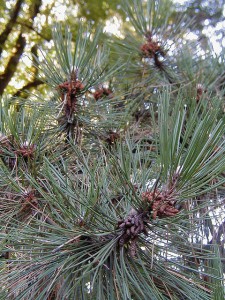
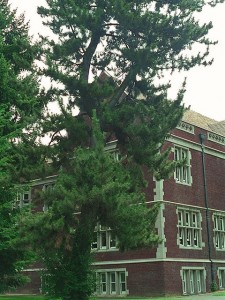 The Austrian Pine is a 2-needled species from western and central Europe eastward into the Balkans, Crimea, and Turkey. Its foliage is a very dark green. The spreading branches of a young tree form a pyramidal outline, but in old age, it sometimes achieves a picturesque flat-topped head.
The Austrian Pine is a 2-needled species from western and central Europe eastward into the Balkans, Crimea, and Turkey. Its foliage is a very dark green. The spreading branches of a young tree form a pyramidal outline, but in old age, it sometimes achieves a picturesque flat-topped head.
View tree page and map.Coast Pine
Scientific name: Pinus contorta
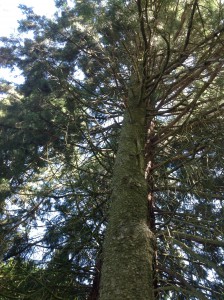 The Coast Pine is a subspecies of the Lodgepole Pine, which is found inland. The Coast Pine, as the name indicates, is found along the coast of much of western North America. It has bundles of two needles. While the Lodgepole Pine is tall and straight, the Coast Pine is often squat and asymmetrical from strong coastal winds. The cones of the Coast Pine point down the branch toward the trunk, while the Lodgepole Pine's cones point out from the branch.
The Coast Pine is a subspecies of the Lodgepole Pine, which is found inland. The Coast Pine, as the name indicates, is found along the coast of much of western North America. It has bundles of two needles. While the Lodgepole Pine is tall and straight, the Coast Pine is often squat and asymmetrical from strong coastal winds. The cones of the Coast Pine point down the branch toward the trunk, while the Lodgepole Pine's cones point out from the branch.
View tree page and map.Eastern White Pine
Scientific name: Pinus strobus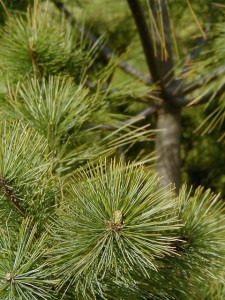
 This is the tallest native tree found east of the Rocky Mountains. It grows up to 80 feet high and has needles in bundles of five. It's the state tree of Maine and Michigan.
This is the tallest native tree found east of the Rocky Mountains. It grows up to 80 feet high and has needles in bundles of five. It's the state tree of Maine and Michigan.
View tree page and map.Japanese Black Pine
Scientific name: Pinus thunbergiana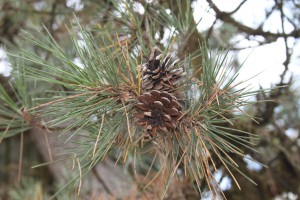
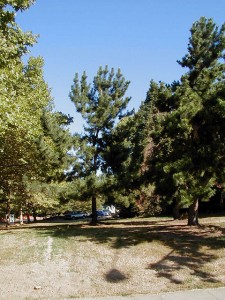 The crown of this pine becomes irregular and spreading as the tree approaches maturity. Its needles come two in a cluster and are 3-4 inches long. Large, white terminal buds help to identify this tree most of the year.
The crown of this pine becomes irregular and spreading as the tree approaches maturity. Its needles come two in a cluster and are 3-4 inches long. Large, white terminal buds help to identify this tree most of the year.
View tree page and map.Japanese Red Pine
Scientific name: Pinus densiflora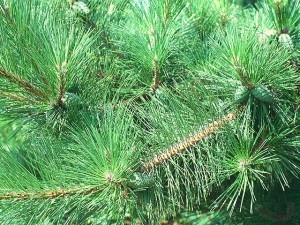 An evergreen, this tree is fast-growing in youth, eventually reaching 100 feet, although it usually tops off at 50-60 feet. The small form of this pine, called `Tanyosho,' normally develops two or more trunks. It has handsome red bark and bright blue-green or yellow-green needles. The plentiful cones are two inches long.
An evergreen, this tree is fast-growing in youth, eventually reaching 100 feet, although it usually tops off at 50-60 feet. The small form of this pine, called `Tanyosho,' normally develops two or more trunks. It has handsome red bark and bright blue-green or yellow-green needles. The plentiful cones are two inches long.
View tree page and map.Jeffrey Pine
Scientific name: Pinus jeffreyi
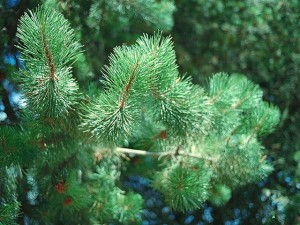 This 3-needled pine closely resembles the Ponderosa, except its needles are longer, stiffer, and grayer, and its cones are twice as long. It is native to southern Oregon and California.
This 3-needled pine closely resembles the Ponderosa, except its needles are longer, stiffer, and grayer, and its cones are twice as long. It is native to southern Oregon and California.
View tree page and map.Ponderosa Pine
Scientific name: Pinus ponderosa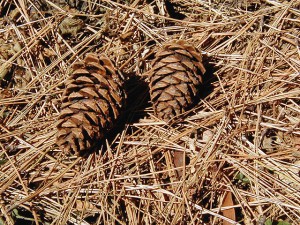
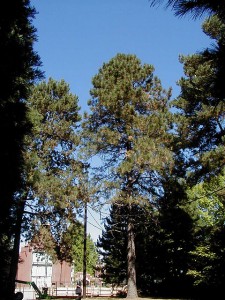 The Ponderosa Pine is the most frequently planted of the large, long-needled native pines. The deep green needles, 6-10 inches long, are arranged in bundles of three. Cones are 3 to 5 inches long. Although found in the interior valleys of western Washington and Oregon, its principal range is east of the Cascades. It is a very important timber tree.
The Ponderosa Pine is the most frequently planted of the large, long-needled native pines. The deep green needles, 6-10 inches long, are arranged in bundles of three. Cones are 3 to 5 inches long. Although found in the interior valleys of western Washington and Oregon, its principal range is east of the Cascades. It is a very important timber tree.
View tree page and map.Scotch Pine
Scientific name: Pinus sylvestris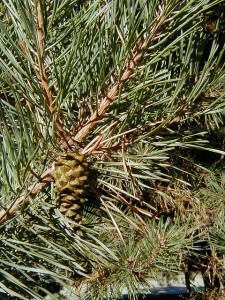
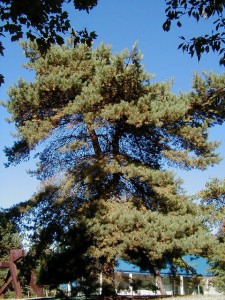 Twisted, blue-green needles of the Scotch pine come two in a bundle. The cones are 2 inches long. The bark is reddish-orange in color at first, maturing to grayish red-brown. Scotch pines are often used as Christmas trees. The species is variable; many strains and cultivars have been developed. It is native from western Europe to Siberia.
Twisted, blue-green needles of the Scotch pine come two in a bundle. The cones are 2 inches long. The bark is reddish-orange in color at first, maturing to grayish red-brown. Scotch pines are often used as Christmas trees. The species is variable; many strains and cultivars have been developed. It is native from western Europe to Siberia.
View tree page and map.Sugar Pine
Scientific name: Pinus lambertiana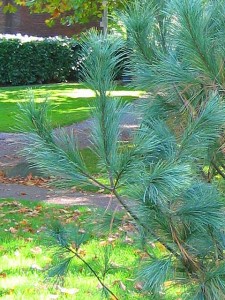
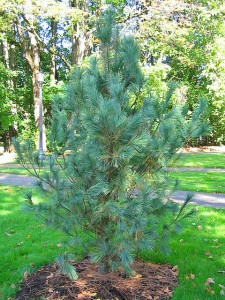 Tallest of all the world's pines, the Sugar Pine grows the largest cones - 15 to 24 inches long - of any conifer. Needles, usually twisted in bundles of five, are three to four inches thick and dark bluish-green. Its sap contains a sugary substance. Found in large areas of the Siskiyou and Klamath Mountains in Oregon, this species was selected as a replacement from the original planting list.
Tallest of all the world's pines, the Sugar Pine grows the largest cones - 15 to 24 inches long - of any conifer. Needles, usually twisted in bundles of five, are three to four inches thick and dark bluish-green. Its sap contains a sugary substance. Found in large areas of the Siskiyou and Klamath Mountains in Oregon, this species was selected as a replacement from the original planting list.
View tree page and map.Western White Pine
Scientific name: Pinus monticola
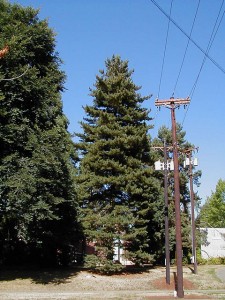 The Western White Pine is native to the western United States from sea level to timberline. It is one of the three 5-needled pines that grow in the Pacific Northwest with needles about 4 inches in length and narrow cones that are 5-10 inches long. It is the state tree of Idaho.
The Western White Pine is native to the western United States from sea level to timberline. It is one of the three 5-needled pines that grow in the Pacific Northwest with needles about 4 inches in length and narrow cones that are 5-10 inches long. It is the state tree of Idaho.
View tree page and map.